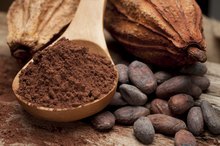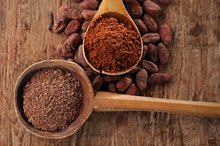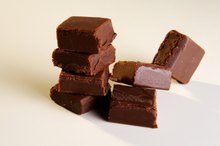Nutritional Information for One Ounce of Dark Chocolate
While it’s important to balance the value gained against calories, dark chocolate’s nutritional benefits are undeniable. It’s a good source of five minerals and even provides two nutrients you might not expect from chocolate: protein and fiber. Different types of dark chocolate contain varying amounts of cacao solids. The percentage of cacao solids sets dark chocolate apart from other types of chocolate and impacts the amount of nutrients you’ll gain.
Identifying Dark Chocolate
After cocoa beans are fermented and roasted, they’re crushed into a paste called cocoa solids or cocoa liquor. The solids may be further separated into cocoa butter and cocoa powder. Varying amounts of cocoa liquor, cocoa butter and cocoa powder are mixed with other ingredients, such as sugar and milk, to produce the wide range of chocolates available in stores. Dark chocolate may contain 45 to 85 percent cocoa solids, but you’ll get the most benefits from chocolate that contains at least 60 percent cocoa solids, according to the University of Michigan Health System.
Calories and Fats Count
List of Foods & Drinks High in Iron
Learn More
One ounce of dark chocolate with 60 to 69 percent cacao solids has 164 calories, 11 grams of fat and 15 grams of total carbohydrates. It also supplies 2 grams each of protein and fiber. These values change slightly depending on the amount of cacao solids. Most values increase as the percentage of cacao solids goes up, except for sugar and carbs. One ounce of dark chocolate with 45 to 59 percent cacao solids has 155 calories and 14 grams of sugar. In chocolate that retains 70 to 85 percent cacao solids, the calories increase to 170 but sugar decreases to 7 grams.
Iron for Energy
Iron in red blood cells carries energizing oxygen throughout your body and stores oxygen reserves in your muscles. It also keeps your immune system strong, supports energy metabolism and helps produce antioxidants that protect your cells from damage caused by free radicals. Since iron is lost through bleeding, women need 18 milligrams daily before menopause. After menopause, women should consume 8 milligrams daily, which is the recommended dietary allowance for men throughout adulthood. One ounce of dark chocolate contains 2 to 3 milligrams of iron.
Boost Your Copper
Can Children Eat Dark Chocolate?
Learn More
One ounce of chocolate with 45 to 59 percent cacao solids supplies 15 percent of your recommended dietary allowance for copper, according to NutritionValue.org. The same portion with 60 to 69 percent cacao solids supplies 18 percent. If your dark chocolate contains 70 to 85 percent cacao solids, the amount jumps to 25 percent of your RDA. Copper primarily functions as an integral component of enzymes. In this role, it’s essential for energy production, iron metabolism and the synthesis of connective tissue. It also helps make antioxidants and keeps your nerves working properly.
Multifunctional Magnesium
Magnesium’s diverse roles include building bones and producing proteins and antioxidants. As an electrolyte, it carries an electrical charge used to keep nerves and muscles working, including your heart muscles. Getting your RDA of magnesium may lower your risk of developing cardiovascular disease and Type 2 diabetes, according to the Office of Dietary Supplements. One ounce of dark chocolate supplies 10 to 16 percent of your RDA.
Related Articles
References
- NutritionValue.org: Chocolate, 45-59 Percent Cacao Solids, Dark
- NutritionValue.org: Chocolate, 60-69 Percent Cacao Solids, Dark
- NutritionValue.org: Chocolate, 70-85 Percent Cacao Solids, Dark
- University of Nebraska Lincoln Extension: Chocolate -- A Functional Food?
- Linus Pauling Institute: Iron
- Linus Pauling Institute: Copper
- Office of Dietary Supplements: Magnesium
Writer Bio
Sandi Busch received a Bachelor of Arts in psychology, then pursued training in nursing and nutrition. She taught families to plan and prepare special diets, worked as a therapeutic support specialist, and now writes about her favorite topics – nutrition, food, families and parenting – for hospitals and trade magazines.









